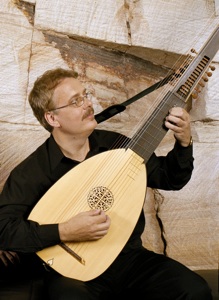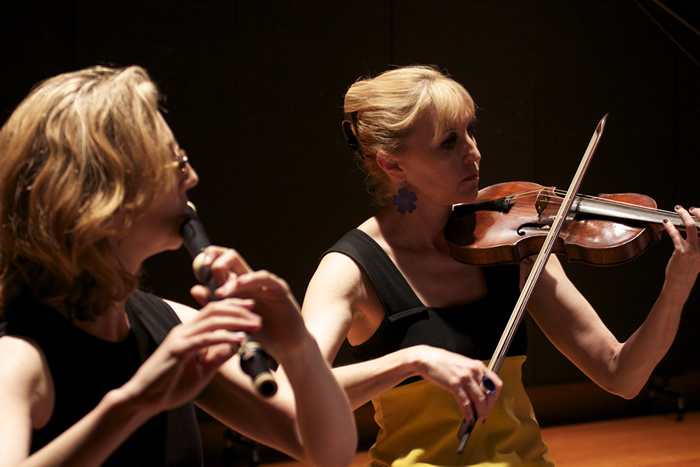On Saturday 30 May 2015, The Independent, North Sydney, will be filled with the rare sounds of Swedish baroque and folk music when The Marais Project launches their new CD. The event has long been a dream of musical partners and Marais Project members, gambist Jenny Eriksson and lutenist Tommie Andersson, two of Australia’s leading early music specialists. Along with a love of baroque music, and in particular, the music of viola da gambist Marin Marais, they also share a Swedish heritage. In this short interview Tommie and Jenny relate something of their Swedish background and the music that came to be a part of Smörgåsbord!. The CD was recently “CD of the Week” on ABC Classic FM.
××××××××××××
Philip Pogson (PP): Tommie, where in Sweden did you grow up and go to school?
Tommie Andersson (TA): I grew up in Bodafors, a small country town of some 2,000 people in the province of Småland, home of IKEA, Orrefors and Kosta Boda glassware and Astrid Lindgren (the author of Pippi Longstockings) and much more.
PP: What are some of the musical memories of your childhood?
TA: My home was not a musical one and the reason I started learning music at all was that a few boys in my class (in year 5) asked me to take up the guitar so we could form a band like the Beatles. I am still very fond of their music, but one thing lead to another and I ended up making my living playing lutes instead. I do enjoy playing “Blackbird” on the theorbo occasionally!
PP: Jenny, what about you?
Jenny Eriksson (JE): Unlike Tommie I did not grow up in Sweden. My grandfather, Knut Axel Eriksson, arrived in Melbourne in 1924. He was a sailor by trade. He never went back to Sweden.
PP: Did you grow up knowing much about your heritage?
JE: We knew Grandpa was Swedish of course, but there was not as much encouragement as there is today to keep up the original culture. Dad went to Swedish church as a child but he did not really learn Swedish until later in his life. However, each year we received letters from a Swedish cousin who wrote to Grandpa which kept up the link to Grandpa’s place of birth. When I first went to Sweden I got to meet this cousin and the rest of my family which was very moving. Interestingly, many of our Swedish relatives are fine amateur musicians and we often play and sing together when we are in the same country!
PP: Are your family musical?
 JE: I can’t remember hearing Grandpa sing but Dad tells he played the mouth organ beautifully. Grandma, who was English, played the piano well and loved South American music. Both of my sisters are fine musicians as well and one, Annette, graduated in music from Sydney University on viola. My Aunt was a music therapist before she retired and still sings in choirs including a Swedish choir in Melbourne.
JE: I can’t remember hearing Grandpa sing but Dad tells he played the mouth organ beautifully. Grandma, who was English, played the piano well and loved South American music. Both of my sisters are fine musicians as well and one, Annette, graduated in music from Sydney University on viola. My Aunt was a music therapist before she retired and still sings in choirs including a Swedish choir in Melbourne.
PP: Tommie, the Baroque period (1600 to 1750) was a time of immense musical change and development across Europe. What was going on in Sweden during these years?
TA: In the 17th century Sweden was a major power in Europe, covering the area of Sweden, Finland, Estonia, Latvia, and the area in Russia where Peter the Great later founded St. Petersburg. Sweden also controlled some parts of northern Germany so the Baltic was a virtual Mare nostrum. Culturally, however, the court in Stockholm was far away from the centres of Paris, Rome and Venice and with wars and a small population, the frozen north did not produce any great lasting achievements.
Queen Christina of Sweden, who was very keen on the arts, enticed Italian and French musicians to visit in order to brighten up the court and the philosopher Descartes was her tutor (apparently very miserable and cold in Stockholm and soon died from pneumonia.). Christina later abdicated, converted to Catholicism, and became a patron of the arts in Rome with composers like Scarlatti, Corelli, Stradella and Pasquini under her wing. At home, the Swedes continued to do what they did best: make war.
PP: Johan Helmich Roman, who features on Smörgåsbord!, is often described as “The Father of Swedish music”. What was his role and how did he come to be given this title?
TA: There were, of course, composers before Roman in Sweden but he was the first of any stature. Through his studies in England (with Pepusch) he got to know Bononcini, Geminiani and Handel and when he returned he was soon appointed Chief Master of the Swedish Royal Orchestra. Through his travels he brought a wealth of music by the great composers of the time to the Swedish court which had a huge influence on the coming generations. He composed orchestral music, cantatas, assagios for unaccompanied violin and 12 flute sonatas; the Drottningholm music is considered his greatest work, written for a royal wedding in 1744. This is a personal favourite of mine; it has 33 movements and is similar in style to Handel’s Water Music.
PP: I imagine that few Australians have an aural image of Swedish folk music. Can you describe some of the key features of Swedish folk?
TA: Swedish folk music is mostly played on the violin; other instruments include nyckelharpa (a type of hurdy-gurdy played with a bow, with roots in the middle ages), various pipes and bagpipe and (in the 20th century) the accordion. The music itself is often in a minor or modal key, with sometimes quirky rhythms and tempered notes (i.e. deliberately slightly sharp or flat).
A lot of the Swedish folk music was notated in the beginning of the 1900s by dedicated musicologists Nils and Olof Andersson (no relations of mine!), so we now have a treasure trove of some 24 tomes in the series Svenska Låtar, with some 8,000 tunes. Every summer there are fiddlers’ festivals all over the country with thousands of participants. It is an experience to be part of this, hearing small groups of fiddlers having jam-sessions from out of nowhere and attending amazing performances by some of the many fantastic players.
JE: My most powerful memory of Sweden is the fiddle orchestras, they have a wonderful, raw, robust sound and people seem to love to play in them. Many of the songs are quite beautiful and Tommie has arranged some for this concert.
PP: Anyone who has spent any length of time in Sweden will have come across the revered poet, Carl Michael Bellman. Can you tell us a little about him?
TA: Bellman is central to Swedish culture – I doubt that there is an adult or child in Sweden who is not familiar with at least some of his songs. He is unique in that he not only set music to his poetry, but also conveyed a dramatic portrait of his time and the life of ordinary people (including drunkards and prostitutes) in Stockholm. The four songs I have chosen for this CD give quite a typical picture of Bellman’s output.
PP: Finally, you have been in Australia for a long time now Tommie. Do you miss “home”?
TA: In 2013 I celebrated spending exactly half of my life in Australia and I became a citizen a few years back. So I would probably consider Sydney “home” now. I also have a beautiful family here and plenty of interesting work. Having said that, there will always be things about Sweden that tug at me: the shimmering lakes and magical forests of Småland, the light of the midsummer’s night and the candles in every window at Christmas. The celebrations of Santa Lucia, when every little country town chooses a beautiful local girl to appear in the morning with candles in her hair. The wild mushrooms and berries in the forest, the elk and reindeer meat and the tasty freshwater perch – I better stop now otherwise I’ll just have to jump on the next plane to Stockholm and we’ll have no concert!
PP: Jenny, is there anything you want to add?
JE: Only that the CD and the concert contain a very interesting mix of baroque and folk songs including one piece by Marais to keep us true to our name. Finally, I should mention that to balance all the Swedish music we have commissioned Llew Kiek of “Mara!” fame to arrange some Australian folk songs for the CD launch concert. This will be a world premiere! Llew also produced Smörgåsbord! so it’s great to have him involved on another level too.
××××××××××××
Date: 7.30pm Saturday 30th May, 2015
Venue The Independent, 269 Miller St, North Sydney
Featuring: Koen van Stade – tenor
Melissa Farrow – baroque flute
Fiona Ziegler – baroque violin
Jennifer Eriksson – viola da gamba
Tommie Andersson –1820s classical guitar & theorbo
Tickets: $38/34 at door; family ticket $100 (2 adults + 2 children);
bookings ph: (02) 9809 5185; on-line at: www.theindependent.org.au/


